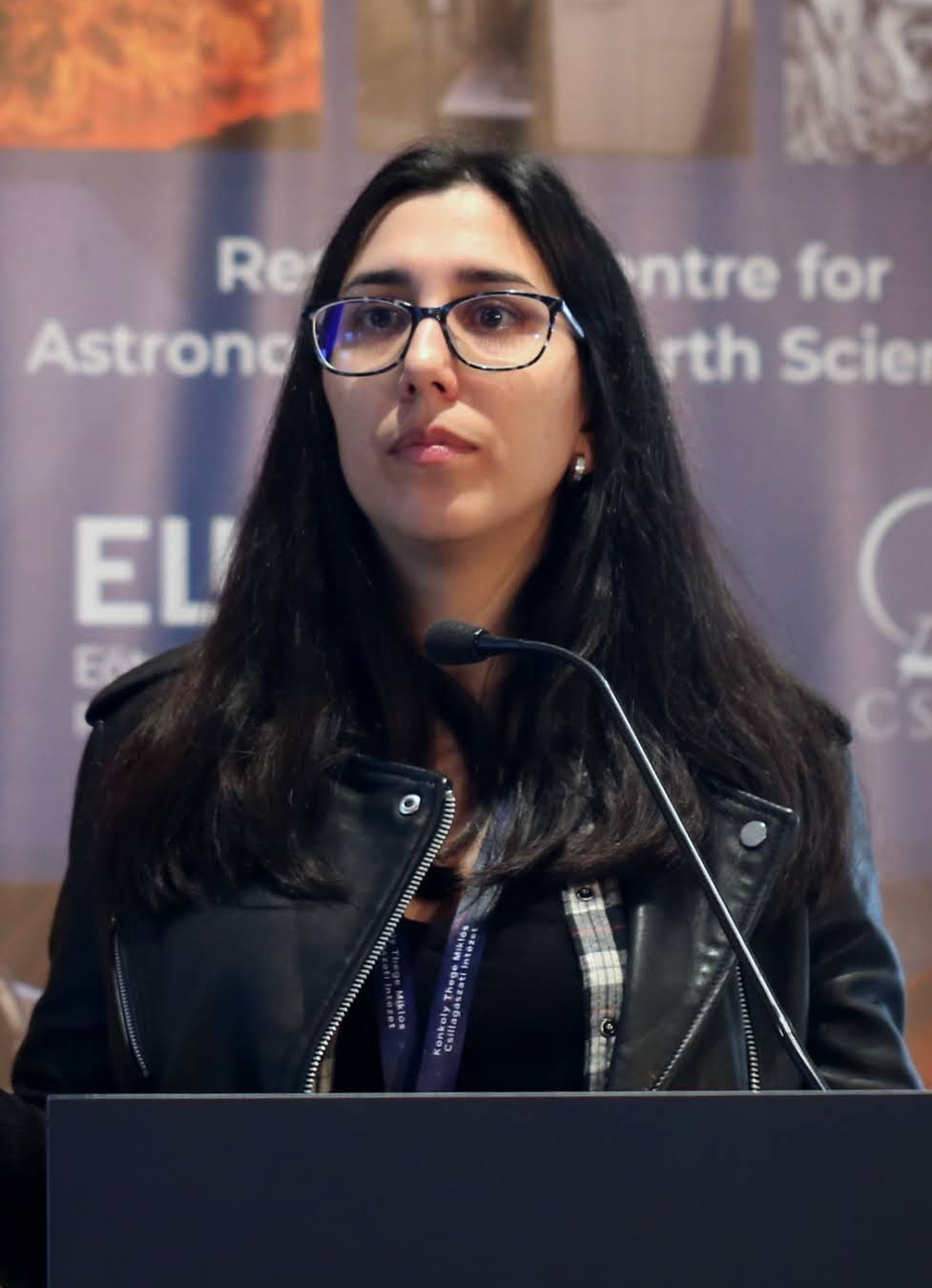My research interests are primarily focused on the use of variable stars as stellar population tracers to study the formation and evolution of dwarf galaxies in the Local Group and also to understand the formation of our own galaxy, the Milky Way.
To the date I have been involved in several projects that search for variable stars in many Local Group dwarf galaxies and outer halo globular clusters located in different environments:
Sculptor (Martínez-Vázquez et al. 2016b)
And VI, NGC 185, NGC 147 (Monelli et al. 2017, Martínez-Vázquez included)
NGC 5824 (Walker, Andreuzzi, Martínez-Vázquez et al. 2017)
And I, And II, And III, And XV, And XVI, And XXVIII (Martínez-Vázquez et al. 2017)
Crater II (Monelli, Walker, Martínez-Vázquez et al. 2018; Vivas, Walker, Martínez-Vázquez et al. 2020)
Grus I, Kim 2, Phoenix II, Grus II (Martínez-Vázquez et al. 2019)
Several ultra-faint dwarfs (Vivas, Martínez-Vázquez & Walker, 2020)
NGC 419 (Martínez-Vázquez, Salinas & Vivas, 2020)
Eridanus II (Martínez-Vázquez et al. 2021b)
Centaurus I (Martínez-Vázquez et al. 2021c)
VV124 and KKr25 (Neeley et al. 2021, Martínez-Vázquez included)
Antlia II (Vivas, Martínez-Vázquez, Walker, et al. 2022)
Fornax (Braga et al. 2022, Martínez-Vázquez included)
And also in big surveys:
Below I summarize my main research topics.
RR Lyrae as distance indicators
Since RR Lyrae stars are radial pulsating variable stars, they obey well-defined period luminosity and period-color relations that provide accurate and precise individual distances. I have used them to obtain accurate distances to several dwarf galaxies.
RR Lyrae as stellar tracers of the old population
Sculptor has been proved to be a gold mine in terms of its early star formation and chemical enrichment. Tolstoy et al. (2004) show that this galaxy has two RGB population with different kinematics and metallicities. In
Martínez-Vázquez et al. (2016a), we derive the metallicity distribution of the RR Lyrae stars in Sculptor and notice that there is a metallicity gradient, showing that Sculptor experienced a fast chemical evolution at its early epochs. We compare the metallicity distribution of the RR Lyrae (old population) with the RGB (age-mixed population) available in the literature. The results of this analysis suggest that star formation in the center of Sculptor lasted substantially longer than in its outer parts, thus constraining the timescales for the outside-in evolution of this galaxy.
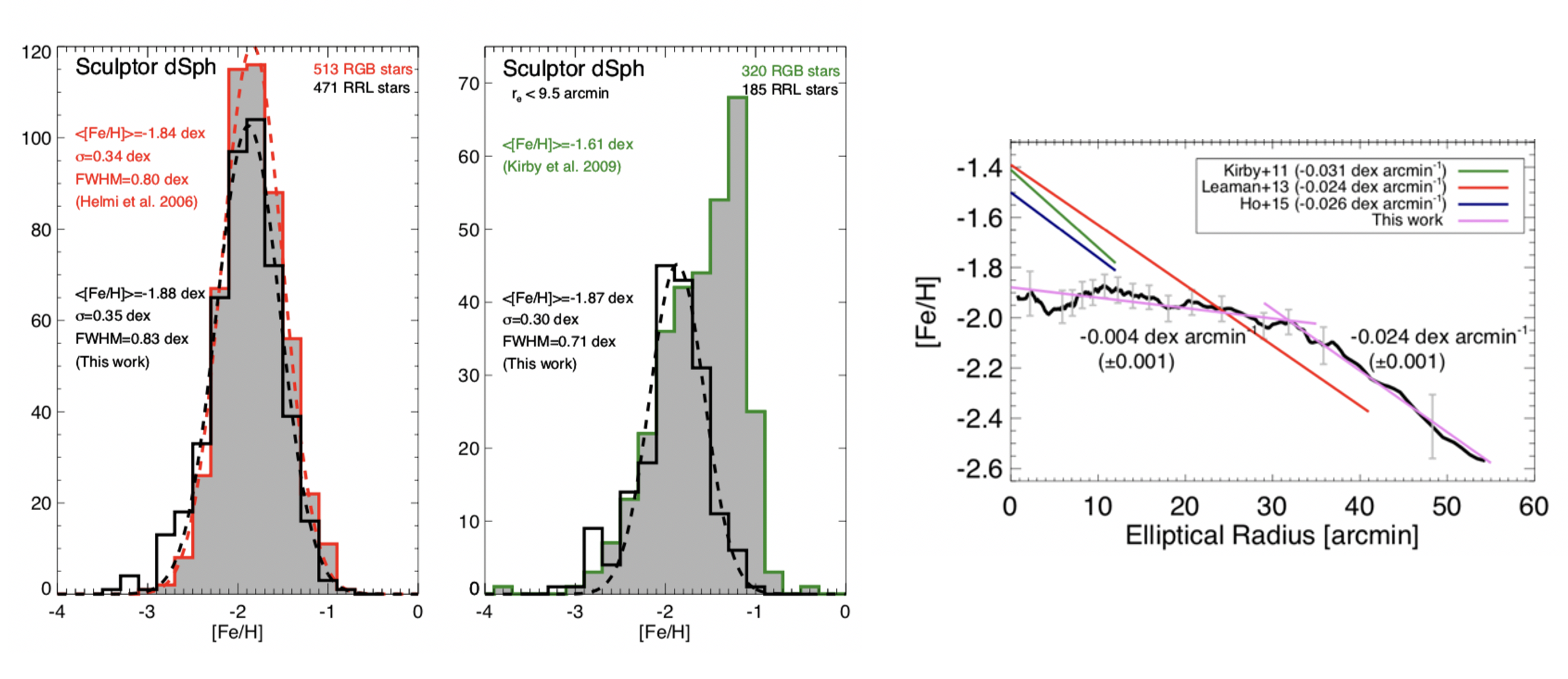
Eridanus II, the only ultra-faint dawrf galaxy discovered lying close to the MW virial radius, is another interest case in this regard. In
Martínez-Vázquez et al. (2021b), we obtained photometric metallicities for their RR Lyrae stars that fitted nicely to horizontal branch synthetic models. Similar to what is found in larger dwarf galaxies such as Sculptor – and in agreement with an outside-in galaxy formation scenario –, we noticed that the more metal-rich RRLs have greater central concentration than the more metal-poor RRLs. This is remarkable in such a faint dwarf galaxy with an apparently single and extremely short (< 1 Gyr) star formation burst (Simon et al. 2021; Gallart et al. 2021).

Comparing the old population in different environments
In
Martínez-Vázquez et al. (2017) we enlarge the sample of M31 satellites with published variability studies. This allows us to compare the pulsational observables of an statistical sample of M31 and Milky Way (MW) satellites for which RR Lyrae data are available. In spite of a slightly difference in the HB morphology (M31 satellites support a redder HB morphology than MW satellites) when we restrict the comparison between M31 and MW systems to the properties of RR Lyrae stars alone, we do not find significant differences between the two groups of galaxies. This suggests overall similar characteristics of the oldest (>10 Gyr) population in the two systems.
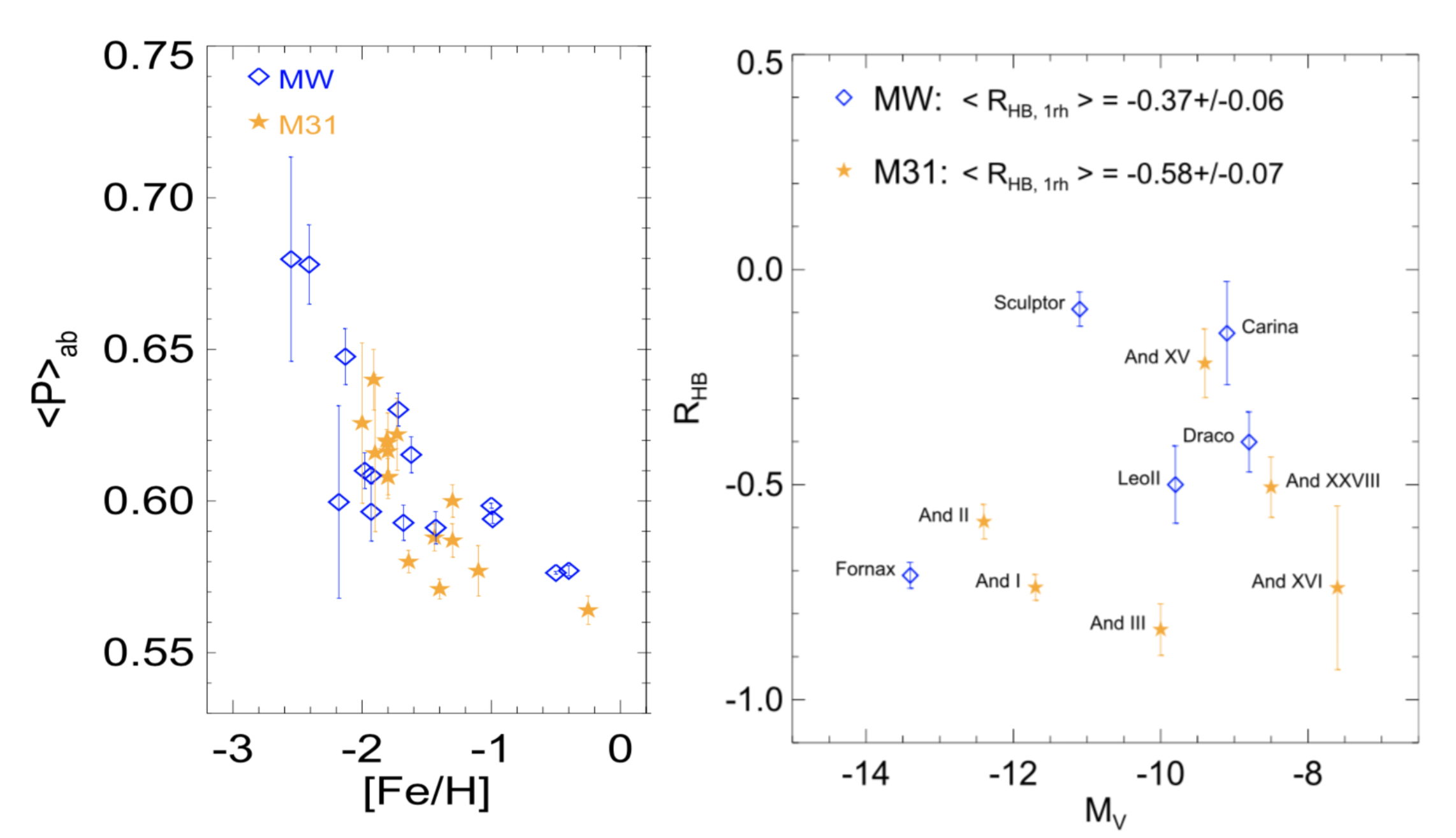
Crater II and Antlia II, the firsts ultra-diffuse Milky Way satellites detected
Crater II and Antlia II are impressively large, comparable to classical dwarfs like Sculptor or Fornax, but their surface brightness is significatively small (> 31 mag arcsec$^{-2}$). Using DECam data, we produce in
Walker, Martínez-Vázquez et al. (2019) the first deep color-magnitude diagram of Crater II that reaches well below the main sequence turn-off and shows that Crater II is an old system with no intermediate age or young stars. The subgiant branch clearly splits in two, showing two burst events of star-formation in its very early epochs. The isochrones indicate a mean age of 12.5 Gyr for the main event and a mean age of 10.5 Gyr for the brighter subgiant branch. With such multiple star formation events, Crater II shows similarity to more massive dwarfs that have intermediate age populations. However, for Crater II, there was early quenching of the star formation and no intermediate age or younger stars are present.
In addition, from the single epoch DECam data we obatined high quality light curves. This allows us (
Vivas, Walker, Martínez-Vázquez et al. 2020a) to obtain accurate pulsation parameters for the RR Lyrae stars that we use to measure a new distance for Crater II of 117 ± 4 kpc.
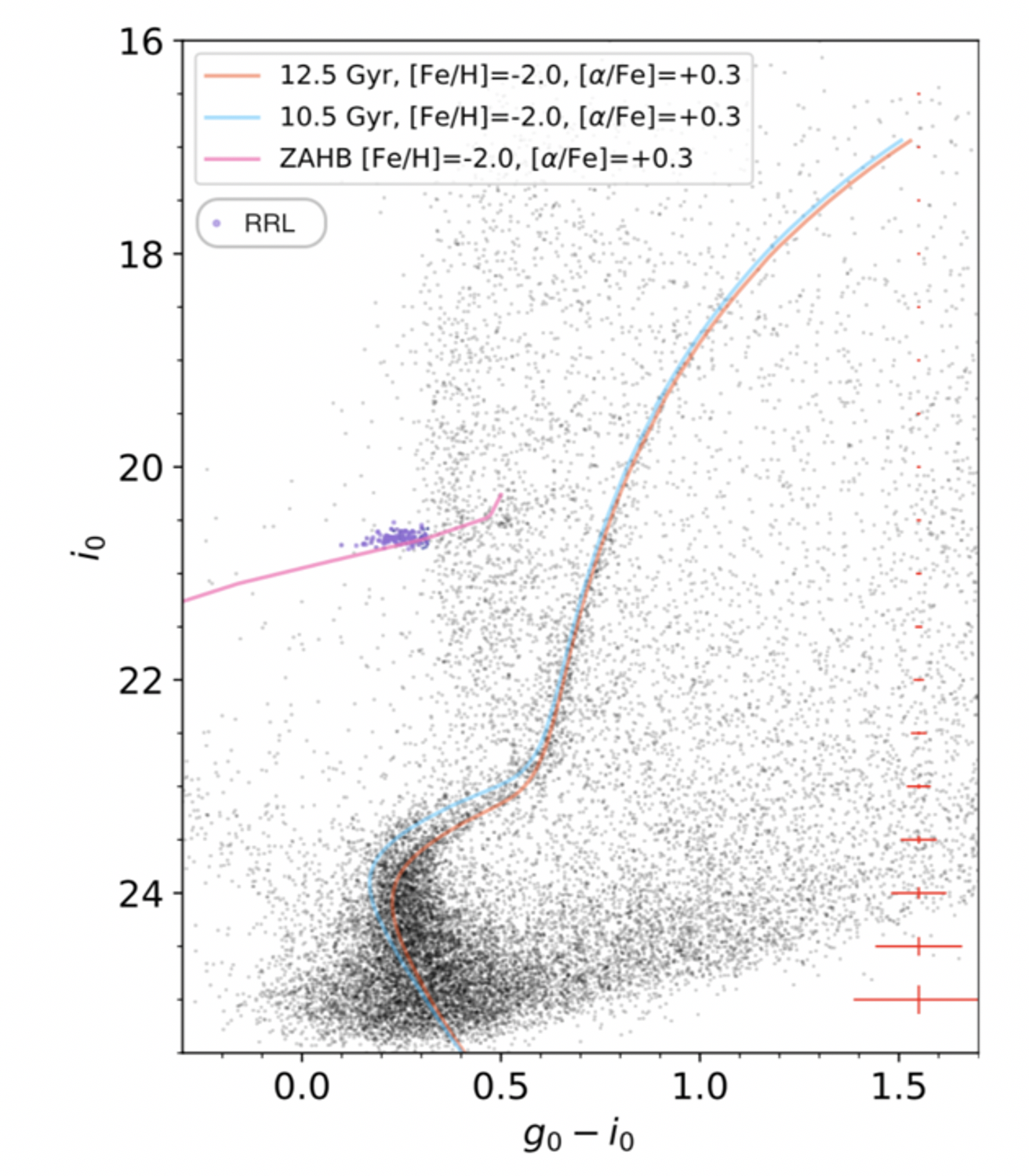
In the case of Antlia II, also using multi-epoch DECam photometry, in
Vivas, Martínez-Vázquez, Walker et al. (2022), we reached well below the horizontal branch and found more than three hundred RR Lyrae stars over the full search area of the galaxy, suggesting its large and extended nature. Using these RR Lyrae stars, we measured an average heliocentric distance (124 ± 5 kpc) and a distance gradient of −2.72 kpc/deg along the semimajor axis of Antlia II, measuring that the SE side of the galxy is ∼13 kpc more distant than the NW. This elongation along the line of sight is likely due to the ongoing tidal disruption of the galaxy and in agreement with the disruption model of Antlia II developed by Ji et al. (2021).

Towards a complete census of RR Lyrae stars in ultra-faint dwarf galaxies
Searching for RR Lyrae stars in the ultra faint dwarf Miky Way satellites is important for obtaining accurate distances to these systems, which then allows the determination of their physical properties and the computation of their orbits. Given that ultra faint dwarf galaxies may be among the most ancient and primitive galaxies, RR Lyrae stars can provide important clues about these systems and also about the understanding of the hierarchical formation and evolution of our own Galaxy. In
Martínez-Vázquez et al. (2019) we find RR Lyrae stars in Phoenix II, Grus I, and Grus II and the new distances measured with them allow us to set their location farther than previously thought (implying larger physical sizes). In
Vivas, Martínez-Vázquez & Walker (2020), using Gaia DR2, we detect 47 RR Lyrae stars associated to 14 ultra faint dwarf galaxies, 24 RR Lyrae stars of which are newly identified as ultra faint dwarf galaxy members.
Furthermore, from a compilation of several variability studies in classical (M$_V < -$ 8 mag) and ultra-faint dwarf galaxies, in
Martínez-Vázquez et al. (2019) we infer that there is a linear correlation between the brightness of a galaxy and the number of RR Lyrae stars in the galaxy, which after updating the number of RR Lyrae stars in
Vivas, Martínez-Vázquez & Walker (2020), has been proved to work very well even in the low luminosity regime. This relation not only foresees the number of RR Lyrae stars but also predicts that the method of finding new ultra faint dwarf galaxies by using two or more clumped RR Lyrae stars may work only for systems brighter than M$_V \lesssim -$4 mag.

Delta Scuti stars in the SMC
Delta Scuti are short period main-sequence pulsating variable stars, tracers of an intermediate-age population (1$-$5 Gyr). The delta Scuti population on the SMC has not been purposefully studied, and only a few, mostly serendipitous detections have been made. Using Gemini-S/GMOS time-series observations, we present in
Martínez-Vázquez, Salinas & Vivas (2020) the first sizeable detection of delta Scuti stars ever made in the SMC, with 54 delta Scuti stars in the field of NGC 419, an intermediate-age globular cluster of the SMC. This allows us to estimate the density of delta Scuti in the field of the SMC for the first time ($\sim$1.6 delta Scuti arcmin$^{-2}$). Thus, several tens of thousands of delta Scuti stars are expected to be found in the whole body of the SMC.
We find that the contribution of delta Scuti into the broadening of the main-sequence turn off (MSTO) of NGC 419 is almost negligible. Only 6 delta Scuti were detected as probable members of NGC 419. The dearth of delta Scuti in NGC 419, with only a few and lying in the red edge of the MSTO, seems a natural implication that the extended MSTO may be caused by the existence of a range of populations with different ages. Interestingly, because only a handful of the delta Scuti appear at the MSTO of the cluster NGC 419, we predict that NGC 419 is younger (t $\lesssim$ 1.2 Gyr) than previously thought.
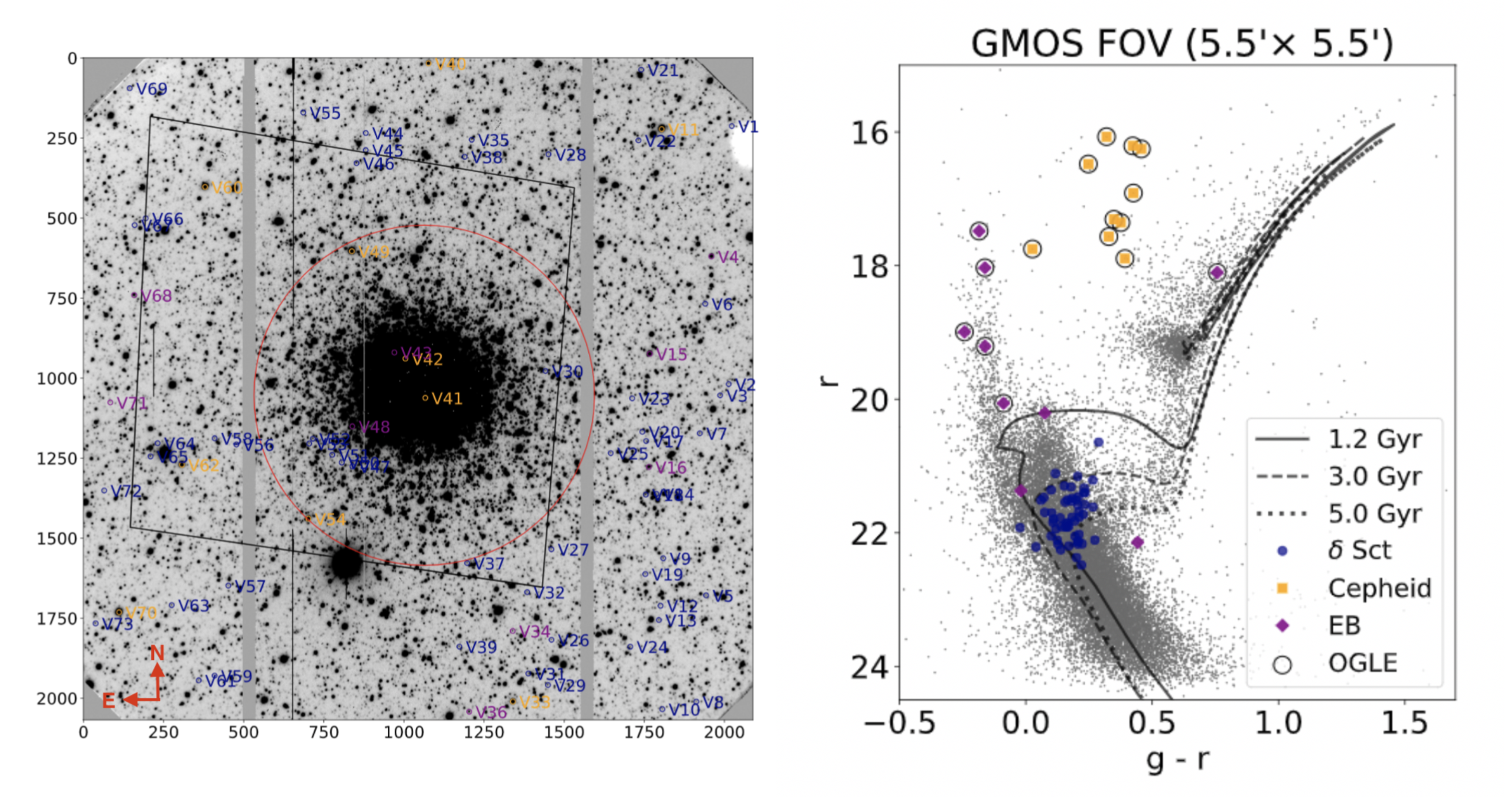
A new and segmented period-luminosity relation for delta Scuti stars
Delta Scuti stars are short period main-sequence pulsating variable stars and have been shown to follow a period-luminosity relation in the visible, thus being potentially useful distance indicators. Their period-luminosity dependency had always been described by a linear relation (Nemec et al. 1994; McNamara 2011; Fiorentino et al. 2015; Ziaali et al. 2019; Jayasinghe et al. 2020; Barac et al. 2022); however, when studying ∼4000 extragalactic delta Scuti stars from the Magellanic Clouds and a few other Milky Way dwarf satellite galaxies in
Martínez-Vázquez et al. (2022), we noticed a non-linear behavior in the period-luminosity relation of delta Scuti stars. The best fit to the period-luminosity plane is given by a piecewise linear relation with a break at log P = -1.03 ± 0.01 (or 0.093 ± 0.002 days). Geometric or depth effects in the Large Magellanic Clouds, metallicity dependence, or different pulsation modes are discarded as possible causes of this segmented relation seen in nearby extragalactic delta Scuti stars. Although the origin of the segmented relation with a break at ~0.09 days remains unexplained, the behavior has proven to be not spurious, visible not only in extragalactic but in Galactic fields as well (De Ridder et al. 2022).









